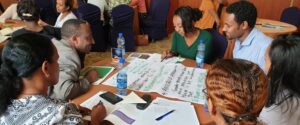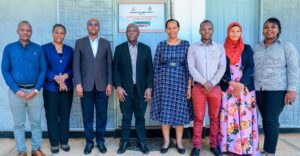ePosters are innovative, interactive and inclusive
I attended the Berlin10 conference in South Africa a couple of weeks ago. The theme was ‘Networked scholarship in a networked world: Participating in Open Access’. Following Open Access Week in October and the INASP’s Open Access Competition — see Anne Powell’s post ‘Open Access 2012‘ for more information — it seemed like a poster at Berlin 10 would be a brilliant way to share some of the achievements.
For most of us at INASP, our experience with conference posters has been rather traditional (see Emma Farrow’s experience at IFLA). So I was intrigued to see that Berlin10 planned a new twist on the static posters I was accustomed to — ePosters. It was great to have an opportunity to put together an ePoster and see how this might increase the possibilities for interaction, reach and responses beyond the conference itself. My poster, ‘The power of networks to increase engagement with open access’, celebrated some of the inspiring, innovative and thought-provoking ways librarians have been reaching out to students, academics and their university authorities.
During her opening speech on Wednesday, Ellen Tise,Senior Director, Library and Information Services at Stellenbosch University, introduced the concept of the ePosters by saying:
“The Berlin 10 Open Access Conference is all about encouraging making research information openly available. In this high-tech world, the focus shifts away from printed material, and we even rethought presenting traditional posters to be presented digitally. The result was that a web page has been created for each poster, which contains the abstract, QR Code, and bit.ly URL for ease of tweeting. In true open access style, they have also been made available on YouTube, where delegates and people from all over the world can post comments and discuss the posters in an interactive way.”
Ina Smith, Berlin10 Conference Coordinator and manager of SUNScholar, the full text research repository of Stellenbosch University’s Library and Information Services, explains how they used the technology to make the biggest impact:
“An electronic poster utilises a large monitor and computer to display multimedia versions of a poster. It gives an opportunity for a computer savvy presenter in the poster session to more effectively convey information that would not necessarily be possible with a traditional printed poster. It also enhances visualisation to attract interest of attendees. Embedding multimedia content, along with static elements, such as titles, logos, and summaries, would be a good way to convey information. Examples of dynamic visual elements include videos, slide shows, animated charts or graphs, scrolling text, or 3D rotation of a model.
The intention of an ePoster does not include attracting visitors to stay for a long oral, video, or slideshow presentation. Display elements can either loop for a minute or less, or be activated and controlled by the poster presenter on command.”
The Berlin10 ePosters all speak of high quality and a lot of thinking went into them to convey powerful messages. We truly appreciated it. The aim was to really give as much exposure as possible to the posters during the Berlin10 conference, utilising the technology.
A web page was created for each of the 29 ePosters, including poster titles, author names, affiliations where available, and abstracts. A QR code and bit.ly URL have also been assigned to each. The QR code and bit.ly URL was part of the programme book handed out to each attending delegate. So delegates could access ePoster from all kinds of electronic devices between sessions, during breaks, etc., tweet about it, etc. The main benefit of this is that audience is no longer restricted to those who attended the conference, increasing the impact and visibility on a global scale.
I was really pleased to be given this opportunity and will explore the ways in which we may utilize similar technology and techniques with our own networks. What has been exciting is that when I now search in Google for my own presentation, I can see it has already been linked to FIRSTPOST in India!




